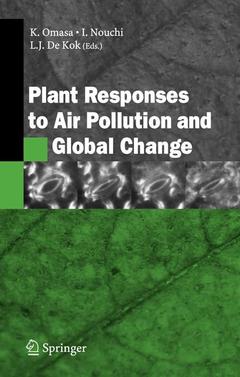Preface by Kenji Omasa, Isamu Nouchi and Luit J. De Kok Contributors Plant Responses to Air Pollution: Metabolism of atmospheric sulfur gases in onion.- Impact of atmospheric NH3 deposition on plant growth and functioning – a case study with Brassica oleracea L..- How sensitive are forest trees to ozone? - New research on an old issue.- Northern conditions enhance the susceptibility of birch (Betula pendula Roth) to oxidative stress caused by ozone.- Physiological responses of trees to air pollutants at high elevation sites.- Complex assessment of forest condition under air pollution impacts.- Evaluation of the ozone-related risk for Austrian forests.- Causes of differences in response of plant species to nitrogen supply and the ecological consequences.- Plant Responses to Climate Change: Long-term effects of elevated CO2 on sour orange trees.- Plant responses to climate change: impacts and adaptation.- Effects of elevated carbon dioxide concentration on wood structure and formation in trees.- Plant Responses to Combination of Air Pollution and Climate Change: Carbon dioxide and ozone affect needle nitrogen and abscission in Pinus ponderosa.- Effects of air pollution and climate change on forests of the Tatra Mountains, Central Europe.- Genetics and Molecular Biology for Functioning Improvement: MAPK signalling and plant cell survival in response to oxidative environmental stress.- Expression of cyanobacterial ictB in higher plants enhanced photosynthesis and growth.- Improvement of photosynthesis in higher plants.- Modification of CO2 fixation of photosynthetic prokaryote.- Specificity of diatom Rubisco.- Regulation of CO2 fixation in non-sulfur purple photosynthetic bacteria.- Experimental Ecosystem and Climate Change Research: Experimental ecosystem and climate change research in controlled environments:lessons from the Biosphere 2 Laboratory 1996-2003.- Importance of air movementfor promoting gas and heat exchanges between plants and atmosphere under controlled environments.- Pros and cons of CO2 springs as experimental sites.- Global Carbon Cycles in Ecosystem and Assessment of Climate Change Impacts: Carbon dynamics in response to climate and disturbance: Recent progress from multi-scale measurements and modeling in AmeriFlux.- Synthetic analysis of the CO2 fluxes at various forests in East Asia 3-D remote sensing of woody canopy height and carbon stocks by helicopter-borne scanning lidar.- Assessments of climate change impacts on the terrestrial ecosystem in Japan using the Bio-Geographical and GeoChemical (BGGC) Model.- Air Pollution and Global Change in Asia: Establishing critical levels of air pollutants for protecting East Asian vegetation – A challenge.- Major activities of acid deposition monitoring network in East Asia (EANET) and related studies.- Land degradation and blown-sand disaster in China.- Impact of meteorological fields and surface conditions on Asian dust.- A case study on combating desertification at a small watershed in the hills-gully area of loess plateau, China.- A recipe for sustainable agriculture in drylands.- Index





